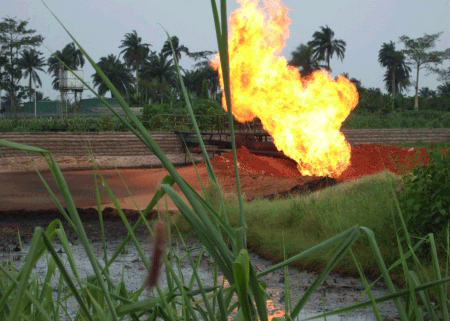Investigating the Resource Curse in Southeast Asia
24 May, 2010 03:23 pm
New evidence suggests that the developing countries of Southeast Asia are not prone to the resource curse when it comes to oil and gas production.
 Nobel Prize winning economists, World Bank officials, and even founding members of the Organization of Petroleum Exporting Countries have all argued that some resources, such as oil or natural gas, can be a “curse” to the countries that have them.
Nobel Prize winning economists, World Bank officials, and even founding members of the Organization of Petroleum Exporting Countries have all argued that some resources, such as oil or natural gas, can be a “curse” to the countries that have them. Known as the theory of the “resource curse”, the central argument is that natural resource endowments can incite, prolong, and intensify government failure and violent conflict. Common examples include Nigeria and Saudi Arabia, countries heavily dependent on oil or other extractive industries for their livelihood but among the most economically troubled, socially unstable, authoritarian, and conflict-ridden in the world.
The theory of the resource curse is worrisome and alarming for Southeast Asia, since resource extraction is anticipated to dramatically increase here. Regulators have especially rushed to invest natural gas, with some analysts expecting the region to become the “the Persian Gulf of Gas,” backed by an integrated Trans-ASEAN Gas Pipeline Network, and someday responsible for one-quarter of the world’s gas production and use.
But does the theory of the resource curse really apply to Southeast Asia? The resource curse, according to the logic presented above, is ultimately connected to geologic factors such as a country’s resource endowment; political factors such as transparency, participation, and corruption; economic factors such as diversification and wealth consolidation; and social factors such as life expectancy and standards of living. Countries suffering from the resource curse would be blessed with certain mineral resources, tend to have less transparency, more corruption, a less diversified economy and more concentration of wealth, and undergo deteriorating social indicators including higher rates of malnutrition, child mortality, and poor educational performance.
One can test these claims with the five ASEAN countries with the largest endowment of combined per capita and total oil and natural gas reserves: Brunei, Indonesia, Malaysia, Myanmar, and Thailand. Metrics can be used to determine the extent that these countries’ resources have “cursed” them by measuring the political dimensions of transparency and authorized levels of oil and gas production. Economic dimensions such as composition of exports, composition of GDP, government revenues, per capita income, rates of poverty, and rates of inflation would play an important role. Social indicators such as education, infant mortality, food security, and life expectancy can also be assessed.
When one looks at these metrics over two decades (from 1987 to 2007), they conclusively show that none of the five countries examined exhibited deteriorating trends in most of the thirteen above indicators. Even though Myanmar performed the worst of all five countries analyzed, it still displayed improvements in education, life expectancy, and per capita GDP. When given a score for how well the group of five Southeast Asian countries performed according to each metric, with a -1 indicating a deteriorating metric and a +1 signifying an improvement, they collectively showed progress in 47 indicators and regressed in only 17 (data for two metrics did not exist).
However, the resource curse is not only about whether resource-rich countries will perform poorly in absolute terms, but also how well they do compared to other countries, both “resource rich” and “average.” To typify “resource rich” countries, one can assess the same data for the five largest oil producers of the Organization of Petroleum Exporting Countries: Saudi Arabia, Iran, Venezuela, Kuwait, and United Arab Emirates. To exemplify “average” developing countries, one could collect equivalent data for Brazil, China, India, Russia, and South Africa.
Interestingly, relying on the same scoring technique, the five OPEC countries as a whole progressed in 43 metrics and regressed in 17 (data for 5 metrics was not available) from 1987 to 2007, and the group of developing countries progressed in 56 metrics and regressed in only 9.
When metrics are compared between groups of countries, a few trends emerge.
In terms of transparency and political openness, Southeast Asian countries performed better than both OPEC countries and developing countries, scoring the highest average as a group on Transparency International’s corruptions perception index.
A significant amount of Gross Domestic Product and government revenues among Southeast Asian countries came from the oil and gas sectors, making them similar to OPEC countries (both sets of countries average more than one-quarter of GDP and revenues from oil and gas) but unlike the developing countries (which received less than 10 percent)
The most remarkable gains in Gross National Product per capita, fighting poverty, and keeping annual interest rates low occurred in the OPEC countries, which saw incomes rise over the period by $8,844 compared to $3,660 for Southeast Asian countries and only $2,746 for the developing countries.
All three groups of countries made progress on social indicators but the developing countries had higher rates of child mortality (one-third higher than the combined rates for Southeast Asia and OPEC) and lower life expectancy (9 percent lower).
While this type of scoring is admittedly crude, it suggests that Southeast Asian countries performed slightly better than the OPEC countries but slightly worse than the developing countries in the metrics related to the resource curse, although each group of countries made significant strides towards improving various political, economic, and social metrics.
Three factors might explain why. The first is those point resources such as oil fields and diamond mines most easily dominated by oligarchs and elites in places such as Sierra Leone or Saudi Arabia are geographically concentrated, but in Southeast Asia oil and gas reserves are more diffused over a broader geographic area.
Second, political institutions and the openness of the political system can play a determining factor in whether the benefits from natural resources are equitably distributed. The major oil and gas producing Southeast Asian countries, with the exception of Myanmar, are all relatively democratic and transparent, have robust property rights, and respect rule of law, with moderate to strong civil society groups and informed constituents. While certainly not uniform, these countries also all tended to focus intently on import substitution, industrialization, economic diversification, and social betterment in the 1980s and 1990s.
Third, Southeast Asian countries can be classified as “producer friendly” as they enroll entrepreneurs and private actors into the resource production process. Rather than resist industrialization and cooperation with international firms, each country has formed active partnerships with major oil and gas companies to assist with exploration, production, and distribution. As of early 2010, at least 10 multinational companies and more than 70 subsidiaries were operating in each of the five Southeast Asian countries selected here.
Ultimately, the situation in Southeast Asia suggests that extractive resources themselves are neither a curse nor a blessing. Instead, it is how they are used and the particular socio-political environment in which they evolve that determines whether they contribute to peace and prosperity, or risk conflict and environmental degradation.
For further reading:
Benjamin K. Sovacool, “The political economy of oil and gas in Southeast Asia: heading towards the natural resource curse?,” Pacific Review 23(2) (May, 2010), pp. 225-259, available at http://www.informaworld.com/smpp/content~content=a922036022.
-
12/12/12
“Peak Oil” is Nonsense… Because There’s Enough Gas to Last 250 Years.
-
05/09/12
Threat of Population Surge to "10 Billion" Espoused in London Theatre.
-
05/09/12
Current Commentary: Energy from Nuclear Fusion – Realities, Prospects and Fantasies?
-
04/05/12
The Oil Industry's Deceitful Promise of American Energy Independence
-
14/02/12
Shaky Foundations for Offshore Wind Farms
1 comment(s)
[1]
Comment by Gates
26 May, 2010 06:16 pm
Investing in these fuels may well be their only option, but soon they are going to need to take up greener ways of getting power.
 Alert Moderator
Alert Moderator







 Read more
Read more